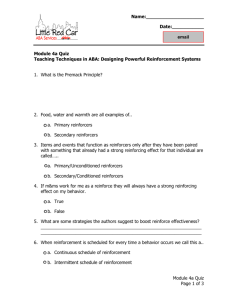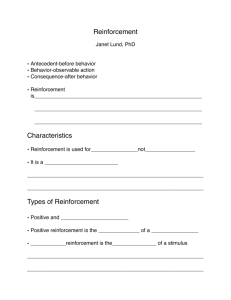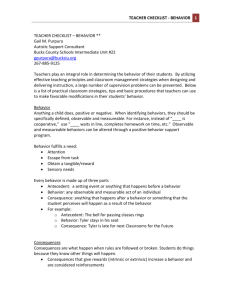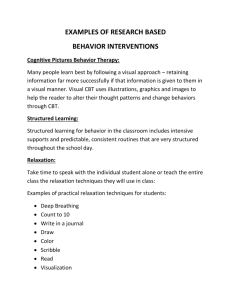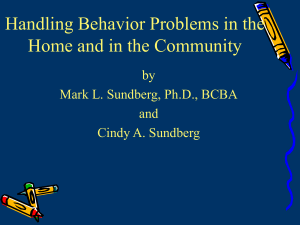Document
advertisement
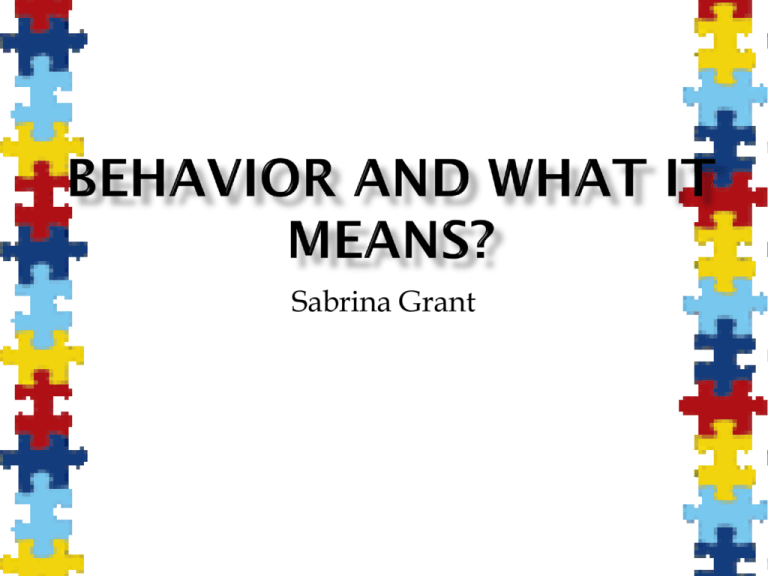
Sabrina Grant Yelling Verbal violence Physical violence Sneaky behaviors Self stimming Running away Refusing to “comply” Brainstorm and we will discuss. It is important to consider that for many individuals with ASD, problem behavior is a result of a lack of knowledge of “what to do” to most effectively access reinforcement. There are many possible causes of negative behaviors The first task is to identify what is causing the specific behavior Use the three-term contingency to identify the cause of a behavior Define the behavior (start small--1 or 2 behaviors) Identify the antecedents (the events before the behavior) Identify the consequences (what happened after the behavior) Antecedent Behavior Consequence Many negative behaviors are caused by inadvertent reinforcement Negative behaviors may get attention, reaction, reprimands, etc. Negative behaviors may get access to reinforcers Negative behavior may allow one to avoid undesirable activities Negative behavior may allow one to escape undesirable activities Negative behavior may be fun (Self-stim, destruction, climbing) Positive behaviors don’t have the same effect e No alternative skills to achieve the same reinforcer (Expressive language) • • • • Reinforcement is anything that increases a behavior Reinforcement can be getting good things (e.g., attention, toys, food) Reprimands and negative attention can sometimes be reinforcers for kids Reinforcement can be getting rid of bad things (e.g., demands, bedtime, putting on shoes) • • • Reinforcement increases good and bad behavior Most reinforcement occurs naturally and unplanned Understanding how reinforcement works is essential to reducing negative behaviors • The three-term contingency (An ABC analysis) Antecedent Child doesn’t want to come inside Behavior Runs from adults Consequence Delays going inside and gets chased • • • • • • First identify the cause and frequency of the behavior Reinforcers are your behavior change tools: Identify and control them Three parts to the intervention Prevention (antecedent intervention) Teach and reinforce (positive) replacement behaviors Change the consequence after the problem behavior (reduce negative behavior) 1st step: Identify the cause using an ABC analysis: For example, seeking attention Intervention: 2nd step: Prevention: Identify high probability settings and time of problem behaviors, and reschedule competing activities (e.g., phone calls, bill paying), plan activities that will engage the child 3rd step: Teach positive behavior: Reinforcement: Deliver reinforcement for appropriate behavior, on a consistent basis (e.g., 10-30 times per hour) 4th step: Reduce negative behavior: Extinction: Ignore minor negative behaviors. Choose your battles wisely. • • • • • • • • • Make sure you really have a reinforcer Deliver the reinforcer immediately after good behavior Set up lots of opportunities for good/correct behavior (Don’t just wait for them) Use a variety of reinforcers Deliver some reinforcers free (pairing) Smile, be sincere, laugh, goof around, have fun with your child Some kids will require lots of reinforcers per hour (3050) Engagement usually is reinforcing! Lack of reinforcement for positive behavior may increase negative behavior At your table brainstorm and then we will discuss. Be prepared for an extinction burst Eye contact is often attention (reinforcement) Don’t show facial reactions Don’t argue, scold or talk (attention) Don’t show anger (attention) Act absorbed in some other activity, walk away Give your child attention shortly after the bad behavior stops Ask for the same behavior under less “high probability” times, and reinforce Break demand into small steps and reinforce each step Make your expectations clear, and be consistent Reinforce approximations Establish time limits for reinforcers Use extra time as reinforcers for no tantrums Obtain the most powerful reinforcers for that child Carefully control and deliver those reinforcers after positive behaviors However, periodically deliver free reinforcers (pairing) Create a hierarchy of demands beginning with the simplest tasks (“clap hands” might be an easy demand) Provide lots of opportunities for the child to comply and be successful Gradually increase the demand, always reinforce Work in short sets of demands throughout the day Work in all environments Transfer control to other adults (generalization) Gradually begin to include high problem area demands (e.g., giving up reinforcers) Occasionally give back the reinforcer when given up Always end the interaction on a positive note Extinction: Do not remove the demand Follow through with the demand Be prepared for an extinction burst Make your expectations clear Caution: Removing the demand will make the problem worse Make sure negative behavior DOES NOT get reinforced in any way Do not promise reinforcers for stopping Do not show reinforcers when engaging in negative behaviors Do not try and “talk a child down” (reinforcement) Be calm, firm and non-emotional. Do not get caught up in an argument or power struggle Anticipate your child’s needs before his bad behavior forces you to meet his needs Avoid situations that you think might make the child irritable (e.g., staying out past their bedtime, shopping for a long time) Start your program in an environment that you can control (not at church, in a store, etc.) Teach others who work with the child how to use these behavioral techniques All negative behavior is communication Use the four steps to reduce a negative behavior 1st step: Use the three-term contingency to identify what causes the behavior 2nd step: Prevent behavior problems (Change the task or demand levels, increase prompts, increase reinforcers for approximations) 3rd step: Actively teach positive behaviors and continue to build on them Identify a wide variety of reinforcers and frequently deliver them for good behavior 4th step: Change the existing consequences for negative behavior Negative behavior often gets reinforced more often than positive behavior Don’t reinforce the problem behavior Ignore minor misbehavior Change is often gradual Learn as much as you can about Behavior Analysis, it is a powerful tool for improving the lives of children with autism and their families
